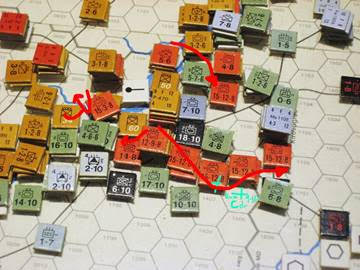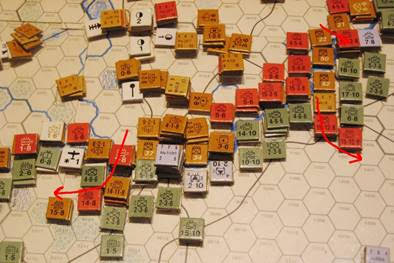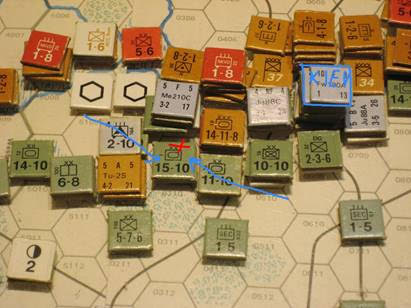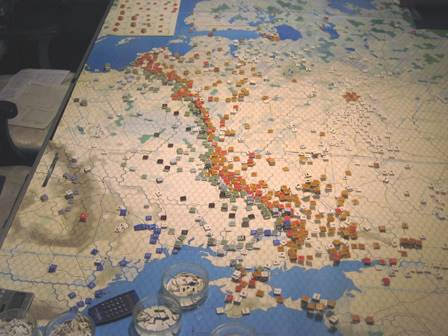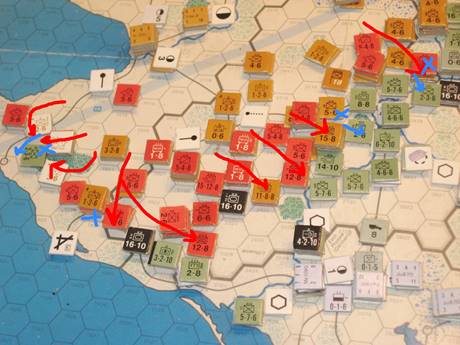Turn Report
Agony and ecstasy on the Dnieper.
This turn brings the long-awaited Soviet breakout from the Cherkassy bridgehead on the North bank of the Dnieper but in a cruel twist of fate typical of the vagaries of war a matching attack from the south through Kherson delivers unmitigated disaster to the attackers and threatens to sets back the Soviet cause by at least a month and to allow Axis forces to flee West.
Partisans: With Axis security forces guarding all rail lines, cities and airfields in the German rear areas partisan groups make their way back though the lines to bolster the troops, or dissolve away back to their farms and dachas.
Due to extra burden the Cherkassy Operation is putting on the Administrative and Staff officers the boundary of the Moscow front is moved south. With the Gomel parallel as the northern boundary and moving the boundary with Stalingrad Front south East 50 miles to include the secondary breakout south of Cherkassy and enable better co-ordination with the main assault.
Arctic front: Two attacks are mounted in this theatre both ineffective. The attack on Lakelva results in a retreat, that at Kautokeino a stalemate.
Leningrad Front: The slow grind continues with 7 attacks. 4 result in DRs, one DE which annihilates a ZOC’d 5-7-6 and a DH and HX. Kaunas is liberated. Mech units consider exploiting through one breach but the presence of powerful panzer divisions and the feared Nebelwerfer Corps persuades them that discretion is, for the moment at least, the better part of valour.
SW of Minsk the secondary road and lack of effective ZOC control by the German defenders allows two Mech Corps to move West rapidly overrunning, in exploitation, the cadre created by their attack on a 5-7-6 inf XX. However they then pull back and consolidate rather than press forward.
Moscow Front: (7 attacks) North of Kiev the isolated 15-8 mech unit desperately attacks back towards the Soviet lines aided by the units he was separated from and reduces to cadre the 11-10pz xx barring the way. Adjacent to that the fortified hex immediately north of Kiev is reduced and occupied, widening the breach. The Mech unit examines the possibility of moving deeper into enemy territory but cowed by the German panzers the 15-8 re-joins the main body of Soviet forces.
At Cherkassy the tip of the advance tackles the 9-10 Rumanian panzer xx. The ½ ATEC of the Rumanians is no match for three 15-12-8s and support units and it caves and its cadre retreats. The cadre is overrun in exploitation and the Soviet tankers form a solid wall from Cherkassy to the outskirts of Kirovograd
In order to strengthen their position, the breach is widened by one hex to the north and a further fort removed from the map together with the 4-6-6 occupant but it does not go all their way for a second hex repels the attackers.
To minimise the risk of a pincer attack against the breakthrough the bridgehead 50 miles south masses and smashes through the German ring holding it against the river where another 4-6-6 meets its end. The exploiting units consider various options but in the end swing in north in a tight loop to hug the units holding the river and form a ZOC ring with their comrades in the north, isolating 3TK (18-10 ss pz xx), the Hungarian 7-10 pz xx, a 5-7-6/1-8AT and a 6-8 pz cdre/4-8 Mech panzer.
Stalingrad Front: (6 attacks) Dnipropetrovsk is assaulted in a massive set piece attack involving Artillery, Combat Engineers and infantry. It falls to the 8:1(-1) attack which eases out the 5-7-6 defender and catches two Me109Gs on the ground.
Around the bend and south side of the river three attacks are mounted by Stalingrad Front forces. At the south-eastern tip a Rumanian 4-6 is eliminated and the river crossed but with infantry only no exploitation is possible. An adjacent attack fails to make any progress and the attack is abandoned (NE).
A third cross-river attack is launched approximately 60 miles East of Kherson this time with armoured assistance. However the attack is repulsed with ease by the Hungarian defenders (AR).
The third assault is a direct assault on Kherson. The attack is at low odds requiring air cover. Problems start on the ground where units fail to reach their jump off points due to stretched supply lines and difficulties navigating the marshy terrain adjacent to the river. Then as if the fates are against them some Soviet aircraft fail to reach the attack zone. With no effective enemy activity, it seems this will still allow the attack to continue but the city is defended by 3 AA points which deliver withering, well targeted and deadly fire against the GS bombers. Fully 1/3rd are removed from the strike. The final 2:1 (-1) odds is less than planned for and the resulting low dice roll seals the fate of half the attacking force. The carnage results in the single highest losses in a Soviet attack of the war. 3 Guards Cavalry Divisions, 2 Guards Infantry, a 13-8 Mech, a 9-6 artillery and numerous support troops lie reduced to cadres or eliminated. A full 50.5 points loss requirement. It is doubtful that the attack can be repeated next turn because there are few replacement troops of that calibre in range. Not only is the loss of troops a blow but had the attack succeeded in capturing Kherson and eliminating the defenders the route would have been open to exploit north sealing the fate of all Axis troops in the Dnieper bend. But this was not to be.
In a pitiful side show compared to the attacks further north in the Crimea the 4-8 Rumanian occupying the sandbar is attacked and retreats north. This will allow the Soviets uninterrupted passage from Kerch.
Air combat: The Soviets suffer badly in the various GS assists and 6 aircraft are lost for none of the enemy. The only consolation is the failure of two Me109gs to escape the capture of Dnipropetrovsk which sends them straight to the Remnant pile.
Combat Report
Attacks: 22 (including 1 Auto)
Losses:
Soviets: 43, 6 x Air
Axis:
Forts (including abandoned) = 9
German = 5 (Isolated), 35 (Non-isolated), 10 pos AA =2
Air (on ground) = 2
Rumanian = 13.
Total = 53
Combat Ratio: May II ’44 Sov/Axis = 53/79 = 1,5
